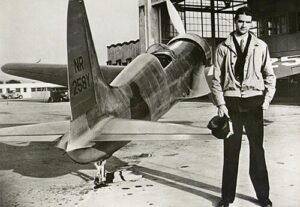Howard Hughes was a pioneer, innovator, and a larger-than-life figure in the world of aviation. His contributions to the field not only revolutionized the aerospace industry but also left an indelible mark on the course of aviation history. In this blog, we will explore the life and accomplishments of Howard Hughes, highlighting his significant influence on aviation. 
The Early Years for Howard Hughes
Howard Robard Hughes Jr. was born on December 24, 1905, in Houston, Texas. From an early age, he exhibited an interest in engineering and aviation. His fascination with machines led him to build his first radio transmitter at the age of 11 and to design and build a functioning motorized bicycle at 12. These early experiences foreshadowed the incredible innovations he would later bring to the aviation world.
Howard Hughes and his H-1 Racer
One of Hughes’s most significant contributions to aviation was the H-1 Racer. In 1935, he designed and built this sleek, cutting-edge aircraft, which set a new landplane speed record of 352 miles per hour. The H-1 Racer showcased his engineering prowess and firmly established his reputation as an aviation visionary.
Hughes Aircraft Company
In 1932, Hughes founded the Hughes Aircraft Company. The company’s innovations extended beyond aircraft, contributing to various areas of technology and defense, but aviation remained at its core. It played a vital role in developing military aircraft during World War II, producing the XF-11 reconnaissance aircraft and the H-4 Hercules, famously known as the “Spruce Goose.”
The “Spruce Goose”
The H-4 Hercules, commonly referred to as the “Spruce Goose,” was a massive wooden flying boat designed and built by Hughes during World War II. This colossal aircraft had a wingspan longer than a football field and was intended for military transport purposes. While it only made one brief test flight, the “Spruce Goose” remains a symbol of Hughes’s audacious ambition and innovative spirit.
Transcontinental and Global Flight Records
Hughes set numerous aviation records during his career, including the fastest transcontinental flight from Los Angeles to Newark, New Jersey, in 1937 and the fastest circumnavigation of the globe in 1938. These accomplishments not only demonstrated his flying skills but also advanced the capabilities of aircraft during a pivotal period in aviation history.
Howard Hughes, his Legacy and Influence on Aviation
Howard Hughes’s influence on aviation extended far beyond his own flying achievements. His innovations in aircraft design, materials, and manufacturing processes pushed the boundaries of what was possible in aviation technology. His attention to detail and pursuit of perfection raised the standards for aircraft construction and performance.
Additionally, Hughes’s entrepreneurial spirit and drive to continually improve aviation technology set a precedent for future generations of aerospace engineers and entrepreneurs. His legacy can be seen in the continued development of faster, more efficient, and safer aircraft.
Wrapping It Up
Howard Hughes’s impact on aviation cannot be overstated. His pioneering spirit, engineering genius, and daring flights revolutionized the aerospace industry and inspired generations of aviators and engineers. As we look back on his life and contributions, it’s clear that Howard Hughes left an enduring mark on aviation that continues to shape the industry today. His legacy serves as a testament to the power of innovation and the limitless possibilities of flight. That’s it until next week’s blog post, so always remember to Be Social, Fly Private!
